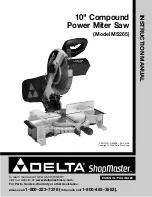
5
FAILURE TO FOLLOW THESE RULES MAY RESULT IN SERIOUS PERSONAL INJURY.
1
. DO NOT OPERATE THIS MACHINE UNTIL
it is
assembled
and
installed
according to the
instructions.
2.
OBTAIN ADVICE from your supervisor, instructor,
or another qualified person
if you are not familiar
with the operation of this machine.
3.
FOLLOW ALL WIRING CODES
and recommended
electrical connections.
4
MOUNT THE TOOL SECURELY
to a stable
supporting surface prior to operation
5.
DO NOT OPERATE SAW WITHOUT GUARDS IN
PLACE.
Check to see that they are in place,
secured, and working correctly.
6
. USE ONLY CROSSCUT SAW BLADES.
Use only
zero-degree or negative hook angles when using
carbide-tipped blades. Do not use blades with deep
gullets. These can deflect and contact the guard.
7.
USE ONLY BLADES OF THE CORRECT SIZE AND
TYPE
specified for this tool.
8.
USE A SHARP BLADE.
Check blade to see if it runs
freely and is free from vibration.
9.
INSPECT BLADE FOR CRACKS
or other damage
prior to operation. Replace cracked or damaged
blade immediately.
10.
CLEAN THE BLADE AND BLADE FLANGES
prior
to operation. Check for any damage and tighten the
arbor nut securely.
11.
USE ONLY BLADE FLANGES
specified for this tool.
12.
CLEAR THE AREA OF FLAMMABLE LIQUIDS
and/or gas prior to operation.
13.
CLEAN THE MOTOR AIR SLOTS
of chips and
sawdust.
14.
TIGHTEN THE TABLE CLAMP HANDLE
and any
other clamps prior to operation.
15.
NEVER START THE TOOL
with the workpiece
against the blade.
16.
KEEP HANDS out of path
of saw blade. Clamp all
workpieces that would require your hand to be in the
“Table Hazard Zone” (within the red lines).
17.
ALLOW THE MOTOR to come to full speed
prior to
starting cut.
18.
NEVER REACH AROUND
or behind the saw blade.
19.
NEVER CUT FERROUS METALS
or masonry.
ADDITIONAL SPECIFIC SAFETY RULES
20.
NEVER RECUT SMALL PIECES.
21.
NEVER LOCK THE SWITCH
in the “ON” position.
22.
NEVER APPLY LUBRICANT
to a running blade.
23.
DO NOT PERFORM FREE-HAND OPERATIONS
.
Hold the work firmly against the fence and table.
Use clamps
to hold the work when possible.
24.
PROPERLY SUPPORT LONG or wide workpieces.
25.
AFTER COMPLETING CUT,
release power switch
and wait for coasting blade to come to a complete
stop before returning saw to raised position. Make
sure saw cuttinghead returns freely to the full raised
position to ensure the lower blade guard fully
encloses the blade.
26.
TURN OFF TOOL AND ALLOW THE BLADE TO
COME TO A COMPLETE STOP
prior to cleaning
the blade area or removing debris in the path of the
blade. A coasting blade can be dangerous.
27.
TURN OFF TOOL AND ALLOW BLADE TO COME
TO A COMPLETE STOP
before removing or
securing workpiece, changing workpiece angle, or
changing the angle of the blade.
28.
NEVER PERFORM LAYOUT, ASSEMBLY,
or set-
up work on the table/work area when the machine is
running.
29.
TURN THE MACHINE “OFF” AND DISCONNECT
THE MACHINE
from the power source before
installing or removing accessories, before adjusting
or changing set-ups, or when making repairs.
30.
TURN THE MACHINE “OFF”,
disconnect the
machine from the power source, and clean the
table/work area before leaving the machine.
LOCK
THE SWITCH IN THE “OFF” POSITION
to prevent
unauthorized use.
31.
ADDITIONAL INFORMATION
regarding the safe
and proper operation of this tool, including a miter
saw safety video, is available from the Power Tool
Institute, 1300 Summer Avenue, Cleveland, OH
44115-2851. Information is also available from the
National Safety Council, 1121 Spring Lake Drive,
Itasca, IL 60143-3201. Please refer to the American
National Standards Institute ANSI 01.1 Safety
Requirements for Woodworking Machines and the
U.S. Department of Labor OSHA 1910.213
Regulations.
SAVE THESE INSTRUCTIONS.
Refer to them often and use them to instruct others




















